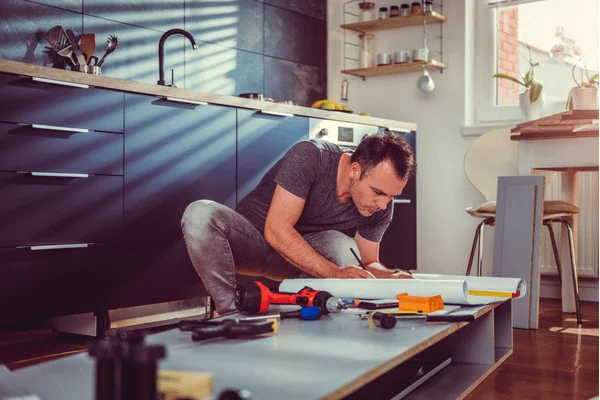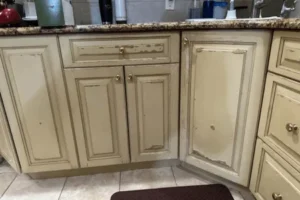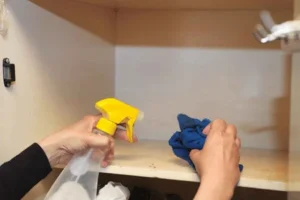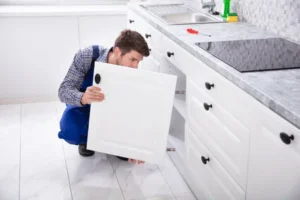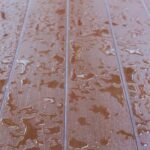Water damage in kitchen cabinets is more common than you might think —and it can happen quickly. A small leak under the sink, a loose dishwasher hose, or excessive humidity can cause cabinets to swell, become stained, or develop mold. The good news? Not every instance of water damage requires a full cabinet replacement. Homeowners who know how to repair kitchen cabinets with water damage can often handle minor problems themselves, saving time and money.
Fixing water damage in the kitchen begins by drying affected areas and assessing the extent of the water damage. Learn how to repair kitchen cabinets with water damage by replacing damaged panels and sealing surfaces. Address mold in kitchen cabinets quickly and fix warped cabinet doors with proper water-damaged cabinet repair techniques.
This guide walks you through identifying water-damaged cabinets, performing simple repair, and knowing when it’s time to call a professional. We’ll cover common signs of damage, and how to decide between repair and replacement. Whether you need to fix warped cabinet doors, eliminate mold in cabinets, or restore the finish, we’ve got you covered.
How to Tell If You Have Kitchen Cabinets Damaged by Water
Kitchen cabinets may look solid, but they can absorb water easily– especially if made of MDF or particleboard. Knowing how to spot damage early will help you limit the scope of repairs and avoid further issues. Water-damaged cabinet renovation starts with a proper assessment. Here’s what to look for:
Visible Signs of Swelling, Peeling, or Discoloration
One of the first clues is a change in appearance. Look for doors or panels that appear swollen, bubbled, or warped. The cabinet finish may peel or crack due to moisture distorting the surface. Discoloration, such as dark stains or blotchy areas, can also indicate the presence of absorbed water. If you see these issues, it’s time to investigate further.
Hidden Damage Behind or Beneath Cabinets
Sometimes, damage can hide in less obvious areas. Check behind cabinets near plumbing lines, under the sink, and beneath toe kicks for signs of mold in the kitchen cabinets or warped wood. Musty odors often accompany hidden water damage. Use a flashlight to inspect these areas thoroughly—early detection makes repairs much easier.
Step-by-Step Guide to Repairing Water-Damaged Cabinets
Fixing water damage in the kitchen involves identifying the source and stopping the leak. Knowing how to repair kitchen cabinets with water damage is crucial when dealing with cabinets that have been damaged by water. Address mold in the kitchen promptly and repair warped cabinet doors as part of a thorough water-damaged cabinet repair.
Not all cabinet damage requires replacement. If caught early, you can often handle water-damaged cabinet renovation yourself. Follow these practical steps to restore your cabinets and help prevent future issues.
Step 1: Dry the Area Thoroughly
Before you begin repairs, it’s crucial to thoroughly dry the affected area. Use fans, dehumidifiers, or a heat gun to eliminate moisture. Remove cabinet doors and drawers to improve air circulation. If humidity remains trapped, mold in cabinets will likely develop, so don’t skip this step.
Step 2: Assess the Severity of the Damage
Next, assess the extent of the damage. Are you experiencing minor swelling or more severe structural issues? Light surface damage can usually be sanded and refinished. Severely swollen, sagging, or crumbling panels may require replacement. If mold or extensive water staining is present, consider hiring a pro for water-damaged cabinet repair.
Step 3: Sanding and Refinishing Minor Damage
For light swelling or peeling finishes, sanding and refinishing may be sufficient. Use medium-grit sandpaper to smooth the damaged area, removing loose or bubbled material. Once the surface is even, apply a primer designed for moisture resistance, followed by a quality paint or clear finish. This restores the look and adds protection.
Step 4: Replacing Swollen or Warped Panels
If the damage is too extensive to sand—such as when you need to fix warped cabinet doors or replace a waterlogged toe kick—panel replacement is the best option. Most modern cabinets allow individual panel swaps. Order matching replacements or consult a professional if your cabinets are custom-built or hard to match.
Step 5: Sealing and Preventing Future Moisture Intrusion
Once repairs are complete, take steps to prevent a repeat problem. Seal seams around sink cutouts, plumbing penetrations, and cabinet bases with waterproof caulk. Install moisture barriers under the sink. Regularly inspect plumbing connections to catch future leaks early. Learning how to repair kitchen cabinets with water damage includes protecting them from future issues.
When to Repair vs. Replace Your Water-Damaged Cabinets
Not sure whether to repair or replace your cabinets? Here’s how to weigh the decision. In many cases, strategic repairs are enough. However, if the damage is extensive or the cabinet materials are of poor quality, replacement may be a smarter long-term investment.
Cost Comparison
Water-damaged cabinet fixes are typically far less expensive than full replacement. Minor sanding and refinishing may cost just a few dollars in materials while replacing a single panel or door runs $50–$200. Full cabinet replacement, by contrast, can cost $5,000–$15,000 or more. Weigh repair costs against the age and value of your cabinets.
Extent of Damage and Mold Concerns
If mold in kitchen cabinets has spread widely or compromised the structural integrity, replacement is usually recommended. Mold remediation can be costly—and leaving any contamination behind risks recurring problems. Likewise, if the cabinet boxes themselves are sagging, crumbling, or pulling away from walls, replacement ensures a safe and lasting result.
Material Type (e.g., MDF vs. Plywood or Solid Wood)
Your cabinet material impacts repair viability. Solid wood and plywood resist water better and are often repairable. MDF and particleboard, on the other hand, swell and deteriorate quickly when wet. If you need to fix warped cabinet doors or crumbling MDF panels, replacing them with more water-resistant materials may be the best move.
Tips to Prevent Water Damage in Kitchen Cabinets
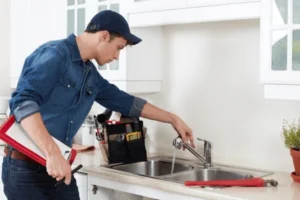
A little prevention goes a long way. By maintaining proper plumbing and protecting vulnerable areas, you can keep your cabinets safe from future water damage.
Proper Plumbing and Sealing Around Sink Areas
Leaky sink fittings and faucet bases are a leading cause of water-damaged cabinet maintenance needs. Regularly inspect plumbing for signs of drips or corrosion. Apply silicone caulk around the base of the faucet and sink to prevent moisture intrusion. Address any leaks immediately to stop water from reaching your cabinet boxes.
Use of Moisture Barriers and Regular Inspections
Install moisture barriers, such as vinyl liners or specialized cabinet mats, under sinks, and near dishwashers to prevent moisture damage. These help contain small leaks and give you time to react before damage occurs. Conduct regular cabinet inspections, especially in high-risk areas. Catching minor issues early prevents more significant problems and reduces the need for repairs to kitchen cabinets with water damage.
Fixing water damage in the kitchen begins with identifying the source of moisture. If left untreated, water damage in kitchens can lead to mold in kitchen cabinets, warping, and structural issues. Knowing how to repair kitchen cabinets with water damage is crucial; start by thoroughly drying the area.
Remove any mold in cabinets using safe, mold-killing cleaners. To fix warped cabinet doors, try clamping them in place or replacing them if necessary. Water-damaged cabinet repair may include sanding, sealing, or repainting. When kitchen cabinets are damaged by water, early intervention helps prevent further deterioration and restores your space to its original condition.
Final Thoughts
Knowing how to repair kitchen cabinets with water damage empowers you to protect one of the most important parts of your kitchen. Many minor issues can be repaired successfully, preserving both your cabinets and your budget. However, when damage is extensive, or mold is present, professional help is often the safest course of action.
If you’re unsure whether to repair or replace your cabinets—or if you’ve spotted mold in kitchen cabinets—SS Water Restoration is here to help. Our experienced team specializes in assessing, repairing, and replacing full cabinets due to water damage. We’ll guide you through the process with expertise and care.
Don’t wait until the damage gets worse—contact us for expert kitchen cabinet repairs today. Contact us today to schedule a consultation and restore your kitchen with confidence.
FAQs
1. Can I repair water-damaged kitchen cabinets myself?
2. How do I fix warped cabinet doors?
3. What are signs of mold in kitchen cabinets?
4. How much does water damaged cabinet repair usually cost?
5. When should I replace instead of repair my kitchen cabinets?

